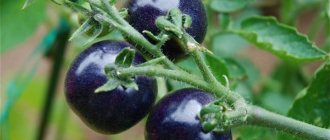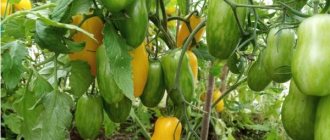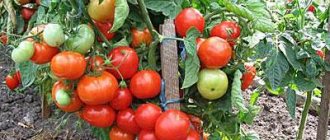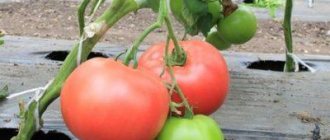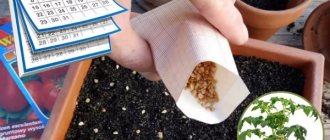Description of the Blueberry tomato variety
The Blueberry tomato from Biotechnika is the result of American selection. It is based on the famous Indigo Rose variety. The new tomato has large fruits and an unusual taste.
The Blueberry variety is an early-ripening hybrid, the fruits of which are harvested 3.5 months after germination. Harvest dates vary in different regions. In the greenhouse, the tomatoes will ripen until the first frost. In the southern regions, the last harvest from open ground is harvested at the end of October.
The variety is zoned for the central zone, but is widespread in other regions of the country. Suitable for growing in open ground and greenhouses.
The plant is indeterminate, shoot growth is not organic. In open ground, the bushes reach 80–100 cm; in a greenhouse they grow more than 1.5 m. The variety is grown mainly on a trellis; pinching is required.
The shoots are powerful, well-leafed, the leaves are bright green. Flower clusters drooping, yellow flowers. Ovary formation is good, there are up to 8 fruits on one branch.
Description of fruits
Blueberry tomatoes at the beginning of growth are no different from other varieties. The fruits are green, during ripening they acquire a violet-blue color, then become dark burgundy with pronounced brown stripes at the stalk.
The tomatoes are large, average weight up to 200 g, even, round. The skin is dense and glossy. In cross-section, Blueberry tomatoes are fleshy, with a small number of seeds, and three-chambered. The flesh of the ripe fruit is completely dark burgundy in color.
Important! Gardeners rated the taste of tomatoes 4.8 out of 5. Blueberry tomatoes are sweet, without acid.
Advantages of the variety
The Blueberry tomato variety was developed by Professor Jim Myers of the Department of Horticulture at Oregon State University (USA). The first purple-colored tomato variety called Indigo Rose was used as the starting material. The Blueberry tomato is the result of selective breeding.
The tall plant belongs to the indeterminate type. During the growing season, it requires removing excess shoots and tying them to a support or trellis. An early ripening variety begins to bear fruit 95-100 days after the sprouts appear.
Blueberry tomatoes are a source of natural antioxidants that contribute to:
- strengthening the circulatory system;
- reducing the risk of developing diseases;
- strengthening the immune system;
- improved vision.
The fruits of this innovative variety owe their exotic coloring to the presence of the purple anthocyanin pigment. This substance is found in significant concentrations in blueberries.
Anthocyanin compounds are necessary for adults to maintain health. The need for natural pigment arises when living in regions with long summers, in case of a genetic predisposition to malignant neoplasms.
The Blueberry variety is characterized by the constant formation of buds, which promotes the setting of new tomatoes. The long fruiting period allows you to constantly pick fresh fruits from the bush.
When cultivating the variety indoors, you can enjoy fresh tomatoes at the end of October. The growth characteristics of the bush allow rational use of the area allocated for planting.
Blueberry tomatoes have a round shape and a glossy surface. In the technical ripeness phase, tomatoes acquire an intense burgundy hue, characteristic of the skin and pulp. The fruits have a pleasant taste. In cooking, tomatoes are used to make desserts.
Simple, long clusters form on the bush, in which 6-8 fruits ripen. The weight of tomatoes is 150-180 g. The variety is characterized by high yield.
The characteristics and description of the variety indicate exceptional plant resistance to diseases. During the growing season, the bushes are not affected by late blight.
Characteristics of tomato
The description and characteristics of the tomato indicate that the variety has good immunity and high yield.
Productivity and fruiting
A special feature of the Blueberry variety is its long flowering and constant fruit set. Fresh tomatoes can be harvested until the end of the season. The first harvest is harvested at the end of July.
The average yield per bush is 1 bucket of tomatoes. The number of fruits is affected by the composition of the soil and fertilizing. Before planting, the bed must be properly prepared.
Area of application of fruits
Unusual Blueberry tomatoes are used for fresh salads and processing. They make delicious sauces, ketchups and juice. Small specimens are selected for whole-fruit canning.
Resistance to diseases and pests
At the genetic level, Blueberry tomatoes have good immunity. They are well resistant to the following diseases:
- late blight of leaves and fruits;
- blossom end rot of tomatoes;
- root rot;
- powdery mildew.
But you don’t need to rely only on plant immunity; preventive spraying is mandatory.
Among the pests, aphids annoy the bushes. In open ground and greenhouses, fruits are often affected by the cutworm caterpillar. Comprehensive measures will help get rid of the pest.
Advantages and disadvantages of the variety
Judging by the photos and reviews, the Blueberry tomato has many advantages, but it is not without its disadvantages. Among the positive characteristics noted:
- good yield;
- good plant immunity;
- large fruits;
- excellent taste of tomatoes;
- versatility of use;
- long fruiting.
In regions with short summers, it is recommended to grow bushes only in greenhouses, otherwise the tomatoes will not have time to ripen. This drawback does not frighten summer residents who decide to enjoy Blueberry tomatoes.
How to grow
This variety is grown according to the standard scheme. The variety is excellent for growing in open ground, as well as in a greenhouse.
At the initial stage, the seeds are sown for seedlings. When the first true leaf appears, they are picked into separate containers. And after several true leaves appear, you can safely plant the seedlings in open soil.
Important to remember! Tomatoes are planted in open soil after the spring frosts have subsided.
To get the harvest earlier, you can plant tomatoes in a greenhouse.
Caring for tomatoes consists of natural measures, such as: watering, weeding, loosening, removing weeds, and, if necessary, fertilizing.
The Blueberry tomato variety will delight you and your loved ones not only with its very unusual color, but also with its excellent taste.
Growing rules
As already mentioned, the new Blueberry tomato variety can be cultivated in open ground and greenhouses, so the magpies for sowing seedlings are different. But the agricultural technology of the crop is standard for tall varieties.
Planting seedlings
For growing in greenhouses, Blueberry tomato seeds are prepared for planting in mid-March. Seedlings for open ground are sown a week later.
The seeds are sold already processed, so no additional procedures are required. The germination rate of planting material is good, reaching almost 100%. Seedlings are grown in containers, then planted in separate containers so that the root system develops well. The soil used is loose, fertile, which allows moisture and air to pass through well.
Important! Before planting, the containers are doused with boiling water and sprayed with a weak solution of potassium permanganate. Especially if they have already been used.
Sowing technology:
- Fill the container with loose substrate, form grooves 1 cm deep.
- Place the seeds at a distance of 2 cm from each other, sprinkle with a thin layer of soil.
- Spray the plantings with a spray bottle and cover with film to create a greenhouse effect.
Until the seeds hatch, maintain the temperature at +20–22 °C. In the phase of two true leaves, tomatoes are dived into separate containers. Then the seedlings are cared for as usual: watered and fed with a weak solution of mineral fertilizers.
Tomato transplant
Tomatoes are hardened 10 days before transplanting. The room temperature is reduced to +19 °C. The seedlings are gradually accustomed to the environment and taken outside.
Tomatoes are transferred to open ground at the end of May, when the threat of return frosts has passed. They can be planted in the greenhouse at the beginning of the month. The bed is prepared in advance. It is good to plant tomatoes after cabbage, cucumbers, legumes and corn.
Planting holes for indeterminate varieties are prepared at a distance of 50 cm from each other. 70 cm is maintained between the rows. Supports are immediately installed along the edges of the beds and trellises are made.
Landing instructions:
- Pour drainage into the bottom of the hole, top it with a mixture of superphosphate, urea and potassium, then fertile soil.
- Install the seedlings, straighten the roots, sprinkle with soil mixture.
- Water the tomatoes generously and mulch with a layer of cut grass or sawdust.
Tall tomatoes are tied above the third leaf. Next, the stem is wrapped around the twine. When the tomatoes reach the top bar, they are thrown over and allowed to grow freely. Form the plant into one stem.
Subsequent care for tomatoes
Caring for Blueberry tomatoes is easy. The main thing is regular watering so that there are no changes in soil moisture. Experienced gardeners constantly mulch plants, so the roots are less likely to overheat. When watering, water should not get on the stems and leaves, otherwise the tomatoes will get sick.
Important! During flowering and fruiting, the Blueberry tomato requires abundant watering.
To get a good tomato harvest, the plants need to be fed. You can use folk formulations or use complex mineral fertilizers. At the beginning of the growing season, nitrogen is added, for example, chicken manure, fermented grass, urea or saltpeter. During the period of flowering and growth of the ovary, they switch to other feedings:
- double superphosphate;
- potassium salt;
- potassium sulfate.
You can use organic mixtures, for example, “Gumate + 7”, ash, a solution of iodine with boric acid.
The formation of a bush in the Blueberry variety affects the amount of harvest. In open ground, all stepsons and lower leaves are removed from the plant. You can grow tomatoes with several stems, it depends on the personal preferences of the summer resident. The main thing is to remove all excess greens.
In a greenhouse, the approach to bush formation is different. Grow a tomato with one stem. The lateral shoots and leaves are completely removed, leaving only the central shoot. In mid-August, the top is pinched to limit the growth of the bush and direct all efforts to ripening the crop.
Important! Excess leaves and shoots take away nutrients from tomatoes, the process of crop ripening is delayed, and the risk of fungal diseases increases.
Bush care
Necessary measures for further care of garlic tomatoes:
- To avoid possible breaking of the stems under its own weight, the tomato is tied to a trellis;
- Loosen the soil between the rows and bushes. The procedure is carried out every 10-12 days. When growing tomatoes on heavy soil, you need to deeply loosen them in the first 10-15 days after planting the seedlings;
- The first hilling is carried out 9-11 days after planting the seedlings;
- Carry out timely watering of plantings, at the rate of 0.7-0.9 liters per bush. It is better to water in the afternoon and in cloudy weather. It is necessary to water during the flowering of the first and second clusters, before loosening, and also after applying dry mineral fertilizers;
- During the entire growing season, fertilizing is carried out using mineral and organic fertilizers.
ATTENTION: Before hilling, be sure to water the soil; moist soil will accelerate the formation of new roots on the stem. The second time they hill up 16-20 days after the first.
Pest and disease control
The Blueberry tomato gets sick if the variety is not cared for properly. To prevent fungal diseases, bushes are sprayed several times with copper-containing preparations. Among the folk remedies, a solution of serum with iodine helps:
- 5 liters of water;
- 1 liter of whey;
- 15 drops of iodine.
You can add grated laundry soap to the mixture to make the solution stick to the leaves better. Treatment is done at intervals of 5–7 days.
It is not always possible to combat caterpillars on tomatoes with chemical means. Among the traditional methods, saline solution has proven itself well. It eats away at the delicate body of the caterpillar and the pest dies.
